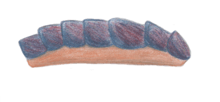Kulindroplax
| Kulindroplax perissokomos Temporal range: Wenlock | |
|---|---|
 | |
| Scientific classification | |
| Kingdom: | Animalia |
| Phylum: | Mollusca |
| Class: | Aplacophora |
| Genus: | †Kulindroplax Sutton, Briggs, Siveter, Siveter and Sigwart, 2012[1] |
| Species: | †K. perissokomos |
| Binomial name | |
| Kulindroplax perissokomos Sutton, Briggs, Siveter, Siveter and Sigwart, 2012 | |
Kulindroplax perissokomos is a Silurian mollusk, known from a single fossil from the Wenlock Series Lagerstätte fauna of England. It lived during the Homerian Age (about 425 million years ago).[1] It is considered a basal aplacophoran. Unlike all modern aplacophorans, which are shell-less, Kulindroplax has a chiton-like shell, and it is considered a transitional fossil in the evolution of molluscs.[2][3]
The only known specimen, described in 2012, was conserved at the Oxford University Museum of Natural History.[1]
Morphology
Kulindroplax is about 2 cm (0.79 in) wide and 4 cm (1.6 in) long.[2] It is the first known mollusk showing an unambiguous combination of valves, or exterior shells, and a worm-like body.[2] It bears seven similar, unarticulated valves, with a shorter head valve and a taller caudal one, lacking ornaments[1] and also several densely packed, 1–2 mm long spicules. It has no discernible foot,[1] and the radula is not preserved.[1] A gill array is present, along with a respiratory cavity opening posteriorly. These features make it more reminiscent of caudofoveate aplacophorans.[1]
While aculiferan mollusks usually bear eight dorsal valves (except for multiplacophorans and Acaenoplax), Kulindroplax bears only seven in a single chiton-like row.
Life habits
Kulindroplax seems adapted to moving through a substrate, with the spicules acting as "sediment ratchets".[1] In contrast with some modern aplacophorans like the caudofoveates, which live within the sea bottom sediments, Kulindroplax probably crawled on the bottom, requiring a dorsal armour.[1]
Evolutionary significance
Kulindroplax settles a 20-year-long dispute about the phylogeny of mollusks, namely the relationship of the worm-like, carnivorous Aplacophora within the group, in particular their relationship to the Polyplacophora.[3] Aplacophorans have been historically variously treated as either a mollusk base-group, distant relatives of Cephalopoda or as a sister group to Polyplacophora in the clade Aculifera.[1] Both molecular and fossil evidence appeared to support the last hypothesis.[4][5][6][7][8] Including Kulindroplax in a phylogenetic matrix with other mollusks and mollusk-like fossil taxa allows to consistently resolve Aculifera as a sister group to Conchifera, in all variants of the analysis, thus bringing the fossil record in line with the recent molecular evidence.[1]
While other fossil taxa like Acaenoplax and Phthipodochiton showed intermediate features between aplacophorans and polyplacophorans, no unambiguous fossil with an aplacophoran-like body and a polyplacophoran-like shell has been found before Kulindroplax.
Below is a cladogram of mollusk phylogeny according to Sutton et al., 2012.[1] Taxa marked with † are extinct.
| ← Lophotrochozoa |
| ||||||||||||||||||||||||||||||||||||||||||||||||||||||||||||||||||
| |
References
- 1 2 3 4 5 6 7 8 9 10 11 12 Sutton, M. D.; Briggs, D. E. G.; Siveter, D. J.; Siveter, D. J.; Sigwart, J. D. (2012). "A Silurian armoured aplacophoran and implications for molluscan phylogeny". Nature. 490 (7418): 94–97. doi:10.1038/nature11328. PMID 23038472.
- 1 2 3 "Ancient mollusk tells a contrary story". Yale News. Retrieved 17 November 2012.
- 1 2 "Mollusc missing link revealed in 3D". Imperial College London. Retrieved 17 November 2012.
- ↑ Kocot, K. M.; Cannon, J. T.; Todt, C.; Citarella, M. R.; Kohn, A. B.; Meyer, A.; Santos, S. R.; Schander, C.; Moroz, L. L.; et al. (2011). "Phylogenomics reveals deep molluscan relationships". Nature. 477 (7365): 452–456. doi:10.1038/nature10382. PMID 21892190.
- ↑ Sigwart, J. D.; Sutton, M. D. (Oct 2007). "Deep molluscan phylogeny: synthesis of palaeontological and neontological data". Proceedings of the Royal Society B: Biological sciences. 274 (1624): 2413–2419. doi:10.1098/rspb.2007.0701. PMC 2274978
 . PMID 17652065. For a summary, see "The Mollusca". University of California Museum of Paleontology. Retrieved 2 October 2008.
. PMID 17652065. For a summary, see "The Mollusca". University of California Museum of Paleontology. Retrieved 2 October 2008. - ↑ Scheltema, A.H. (February 1, 1993). "Aplacophora as Progenetic Aculiferans and the Coelomate Origin of Mollusks as the Sister Taxon of Sipuncula". The Biological Bulletin. 184: 57–78. doi:10.2307/1542380. JSTOR 1542380.
- ↑ Vinther, J.; Sperling, E. A.; Briggs, D. E. G.; Peterson, K. J. (2011). "A molecular palaeobiological hypothesis for the origin of aplacophoran molluscs and their derivation from chiton-like ancestors". Proceedings of the Royal Society B: Biological Sciences. doi:10.1098/rspb.2011.1773.
- ↑ Smith, S. A.; Wilson, N. G.; Goetz, F. E.; Feehery, C.; Andrade, S. N. C. S.; Rouse, G. W.; Giribet, G.; Dunn, C. W. (2011). "Resolving the evolutionary relationships of molluscs with phylogenomic tools". Nature. 480 (7377): 364–367. doi:10.1038/nature10526. PMID 22031330.